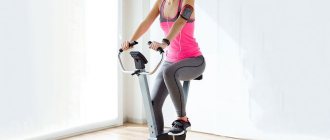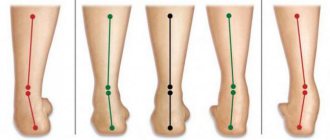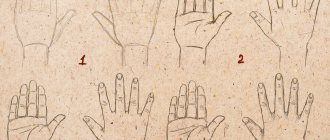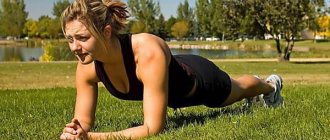Most ordinary modern residents of megacities are characterized by leading a sedentary lifestyle. Working in offices, traveling in cars and minibuses replace walking, which is of great importance for health.
Walking is an everyday activity that many people regard as a necessary effort to move, usually over short distances. Medical experts, on the contrary, argue that the level of benefits for health and well-being of walking is no less important than a competent diet, daily routine, and the like.
Based on scientific research, it has been determined that muscles become toned when walking , and they are not subjected to debilitating loads, as well as significant expenditure of effort or time resources. It is much easier for people who prefer walking to maintain their health, gaining a surge of strength and good mood. And if you walk in a friendly company, or take your music player with you, this activity turns from routine to fun.
How many muscles work when walking?
A newborn person cannot walk for a year or a little more, because for this process it is necessary to first develop more than 200 muscles, as well as learn to use them.
During walking, there are two phases - transfer and support, in which the following muscles actively work:
- lumboiliac;
- biceps femoral;
- ischiofemoral;
- toe extensors;
- gluteus maximus;
- quadriceps femoral.
But the leg muscles are not the only ones that take part in the movement process. To hold the human body in an inclined position when moving the leg, the following muscles contract:
- trapezoidal;
- latissimus dorsalis;
- rhomboid dorsal;
- straightening the spine;
- longest dorsal
During a backward step, the following muscles tense:
- straight abdomen;
- external oblique abdomen;
- internal oblique abdomen;
- transversus abdominis;
- square loin.
While walking, a person also moves his upper limbs, and the following muscle groups are involved:
- anterior deltoid;
- pectoralis major;
- coracobrachial;
- biceps brachialis;
- subosseous;
- small and large round;
- shoulder;
- elbow and many others.
Reference! When walking, the body uses about 200 of the 656 muscles.
Which muscles receive the greatest load when walking?
If we talk about regular walking, there are the following varieties:
- Regular walking exercise - works the back, hips and buttocks.
- Fast walking - works the buttocks, hips, back, calf muscles and core muscles.
- Climbing stairs - the main load is taken by the muscles of the thighs and calves.
The main load during normal walking is taken by the bi- and quadriceps muscles of the thigh, gluteal and calf muscles . But in addition, dozens of stabilizer muscles and core muscles are involved in this process.
When climbing uphill, the same muscles will work, but the back, buttocks, and quadriceps will receive more load.
Nordic walking works the cervical-shoulder region, pectoral and scapular muscle areas, delta and abs, and of course the calves and glutes.
With the sports variety, the calf, gluteus maximus and core muscles work.
Best exercises
A complex for buttocks, weight loss, or simply to improve the condition of the body can be developed independently, experimenting and complicating it. But initially it is better to use the optimal platforms.
Did you know? Running and stepping on steps are part of the training program for tennis players.
For newbies
If you're just starting out with stair climbing, don't rush it. The maximum that is allowed is lifting with weights. And you don’t have to carry it in your hands—you can put the load in your backpack. Dumbbells and water containers are used as ballast.
To get started, stick to this schedule:
- Week 1-2: steps up and down at a slow pace (10-15 min.);
- Week 3-4: running at a moderate pace - 5 minutes, then walking for 10-15 minutes.
Over time, when you master the climbs, you can include light physical exercise in your training.
For each training, spend 15-30 minutes, and in this order:
- Jumping.
- Tiptoe rises.
- Elongated steps.
- Cross lifts.
- Raises on legs and arms.
The cycle is repeated 3-4 times. In proportion to training, the length of the lesson can be increased by increasing the number of training sessions.
Physically developed people can perform a more complex complex. As with simpler techniques, you must first stretch your muscles by walking 3-4 flights.
Exercises are performed for 30-50 seconds, following this order:
- Running up the steps.
- Squat jumps.
- Uneven-high squats (to the sides).
- Straight and reverse push-ups.
Did you know? In gyms they offer to use a step substitute - a stairmaster.
As you can see, walking up the steps is not only simple, but also useful. And the main advantage of such a “simulator” is its accessibility. By following all the recommendations listed above, you can improve your body shape and lose a couple of extra pounds.
The step machine is one of the most popular machines that you can see in any gym. Its popularity can be explained by the fact that in the modern rhythm of life with sedentary work, we often lack walking, the benefits of which no one will argue. Some people prefer to work out in the gym, while others prefer to buy a step machine for home, which is quite convenient. The only difficult moment is the problem of choice.
What is the name of the walking machine? It is called a stepper or stepper. This is a cardio machine that simulates climbing stairs. The name is quite understandable: “step” is translated from English as “step”. Just like other cardio equipment, the stepper helps provide a person with the necessary volume of natural movements. The exercises are primarily aimed at working the muscles of the thighs, buttocks and legs.
One of the advantages of the simulator is its ease of use. It is also relatively inexpensive and takes up little space. For home use, people most often buy mini-steppers, which are attractive due to their compactness and functionality.
A walking simulator is most often purchased to lose weight and improve figure tone. In fact, the benefits of the stepper are not limited to this. The in-situ walking machine is also useful for the following:
- Strengthening the heart and blood vessels;
- Development and stimulation of the respiratory system;
- Activation of the back and abdominal muscles.
For cardio exercise, it is usually considered incorrect to describe working muscle groups and so on. However, in the case of a moving staircase, an exception is made. After all, the buttocks and thighs are worked out perfectly on it.
- The main muscles worked are the gluteals, hamstrings, and calves;
- Auxiliary muscles: core muscles, soleus muscles, back muscles.
- Strengthens the heart and blood vessels;
- Helps normalize metabolism;
- Corrects physical inactivity;
- Helps strengthen the muscles of the legs and buttocks for those who do not strive for strength training;
- Helps get rid of routine in training programs;
- Suitable for fitness bikini training and specialization in the development of gluteal muscles;
- Can be used at home:
- Replaces impact types of exercise, such as running and jumping;
- Allows you to significantly increase calorie consumption;
- Increases the energy intensity of any exercise;
- Suitable for high-intensity interval training
- In cardio training, the main thing is to choose an adequate mode that would suit your training goals. If the goal is to burn excess fat or recover, the workout should not exceed an hour in time. For those who want to preserve muscle and improve physical condition during cardio training, intervals are suitable. They can't last more than 20 minutes and still be very effective;
- Before starting training, you should perform joint exercises. It is not enough to just warm up your knees and ankles; you need to pay attention to your shoulders, elbows, and wrists. 8-9 rotations are enough;
- Training should begin in a low heart rate zone, usually no higher than 40 percent of maximum;
- Warm-up lasts 5-10 minutes, the transition to working intensity should be smooth, the body should work into the load;
- The goal of warming up on a moving staircase is to gradually increase your heart rate. Therefore, for effective work it is necessary to monitor the pulse and accelerate it slowly. Warm-up on a moving staircase occurs at a slow pace, but with the same step height;
- Only the main part of the workout is carried out at the working pulse; the cool-down is also carried out at a low pulse. The purpose of the cool-down is to calm the heart.
Execution Rules
- Walking without support is the most energy-intensive way to cope with this type of load. This type of walking on a stepper is extremely useful and implies an optimal load. If a person slightly holds on to the handles, it is not scary;
- The biomechanics of working with the hands resembles the movements during running, the hands move along the body, they are quite relaxed, and do not help, but do not interfere with the movement;
- The knees should not be inserted, the ankles should not be overstrained due to sudden straightening;
- The range of movement should remain natural. The step is performed in the same way as in ordinary life. You should work with slightly pointed toes, soft ankles and knees;
- The legs do not straighten completely, even if you step over a step. It is worth abandoning the forced increase in the amplitude of movement if it is not possible to walk over a step and increase the amplitude of movement;
Errors
- Back too bent;
- Heel lifting and toe walking;
- The opposite problem is walking exclusively on your heels;
- Hanging (support) on handrails;
- Stooping, arching in the thoracic and lumbar regions;
- You can load the gluteal muscles by swinging your free leg back after each step;
- Some people use a hip circle for the hips, that is, a circular shock absorber. It should fix the legs in a certain position and make it difficult to step. Due to the shock absorber, you can use the adductor muscles of the thigh more and work the buttocks;
- Some trainers equate sideways and upward steps with a shock absorber to a full buttock workout;
- The resistance level of the machine can be adjusted. Interval loading style varies depending on how the resistance is set. You can make it as large as possible, and due to this, work the muscles of the legs and buttocks more;
- The workout may not be the longest, but the calorie burn will be higher due to the higher level of resistance;
- For aerobic endurance, it is recommended to train at a heart rate of 85% of the maximum heart rate; for weight loss, the heart rate may be lower, but the training should continuously last more than 20 minutes if it is performed at a steady pace.
What kind of walking (type) is considered the most useful?
There can be no clear answer to this question. The thing is that each type of walking (including the walking step) is useful in its own way. Not all people will benefit from intense pacing, for example. This is contraindicated for older people who have had heart attacks or strokes. Also, unprepared people who have just started training should not overexert themselves. At the same time, well-trained people will not benefit from a regular brisk walk. So, the benefits of a particular type of walking are determined individually, and depend on a large number of factors.
Reference! The Japanese, who are famous for their longevity, consider it simply necessary to walk 10,000 steps a day. And this is quite possible if you replace transport with walks, give up the elevator, and walk to the store.
How to replace stairs
You can replace the exercise machine with regular walking or running up the stairs. Sometimes people take escalators in supermarkets or subways for cardio, but it's a little different and not as safe. Therefore, those who do not have access to exercise equipment are simply recommended to go down to the front door.
Climbing workouts can burn a lot of extra calories, strengthen the muscles of the legs and buttocks, and for some, even help to enlarge the buttocks and change their shape. Therefore, it is worth trying this simulator if you want to add variety to your training.
The leg muscles are tired when walking, how to quickly restore them?
To relieve leg fatigue, it is recommended to perform the following set of exercises:
- Rise on your toes and stand there for 30 seconds, then return your foot to its original position and repeat the exercise 5-10 times.
- Place your right foot upright and the toes of your left foot on the floor, hold for 30 seconds, then repeat the same on the other leg.
- Place your palms on the wall, take your right leg back and press your toes into the floor, try to lower your heel, hold for 30 seconds, repeat the same for your left leg.
- Place a tennis ball under the arch of your foot and roll it from your heel to your toes, repeat the exercise 50 times for each foot.
- Lie down near a wall and lift your legs up onto the wall at right angles to your body. It is recommended to lie in this position for 15-20 minutes.
Tips and tricks
Before you start walking actively, listen to the advice of experts:
- You need to start practicing walking from short distances and with minimal load. The average speed should be 6 km per hour, and you should try to walk about 5 km per day.
- Use special bracelets, applications on smartphones and other gadgets that will monitor your heart rate, speed, number of steps, and others.
- The load should increase gradually; when you feel that you can easily move at the set pace, you can increase it slightly.
- You shouldn’t expect instant results – the key to success is regular exercise.
- Wear comfortable shoes and clothing.
- Don't go on a full stomach.
- Breathe correctly - inhale through your nose, exhale through your mouth.
Any type of walking will involve the main muscles of the musculoskeletal system - they will receive stress and exercise. But most importantly, the main muscular organ – the heart – will be involved. Walking has a positive effect on his condition - active oxygen saturation occurs. At any level of exercise, walking will make you more resilient, train your body and help relieve stress .
How to learn to walk?
You need to acquire this useful habit, and it’s not difficult to do:
- Replace traveling by transport to and from work with walking . This is especially nice during rush hour. Just imagine: your colleagues are traveling in a crowded, dusty bus, late and nervous, in a bad mood. You walk to work or classes on foot, breathing in full lungs of fresh air and enjoying the surrounding nature. Get up early so as not to be late and have a good walk before the work day.
- Avoid using the elevator in favor of taking the stairs . This is a very effective remedy for cellulite and fat deposits on the thighs and buttocks. Women will appreciate it.
- As you know, it takes 21 days to develop a habit, so force yourself to walk regularly for three weeks and this activity will give you pleasure.
- Choose picturesque places for walks , avoiding roadways and dusty highways. Breathing polluted air is unpleasant and harmful, so walk through parks and alleys, choosing quiet streets with green areas.
- Walking shoes should be comfortable and comfortable . It is unlikely that you will want to walk in patent leather shoes with fifteen-centimeter stiletto heels. Such a walk will seem like a living hell to you. Therefore, it is recommended to wear the most comfortable shoes possible. The ideal option would be running shoes.
- Teach all family members to a healthy habit . So that you don’t get bored while walking, involve your husband and children in this activity. Then your walks will not only be healthy, but will also be a wonderful time spent with your family in the fresh air.
- Increase your sexual desire and arousal . Walking in the fresh air contributes to a rush of blood to the pelvic organs in both men and women, therefore restoring sexual desire and initial attraction. Sexual relationships are very important for people's health, so if you lose sexual desire, you should take a walk in the fresh air before going to bed.











